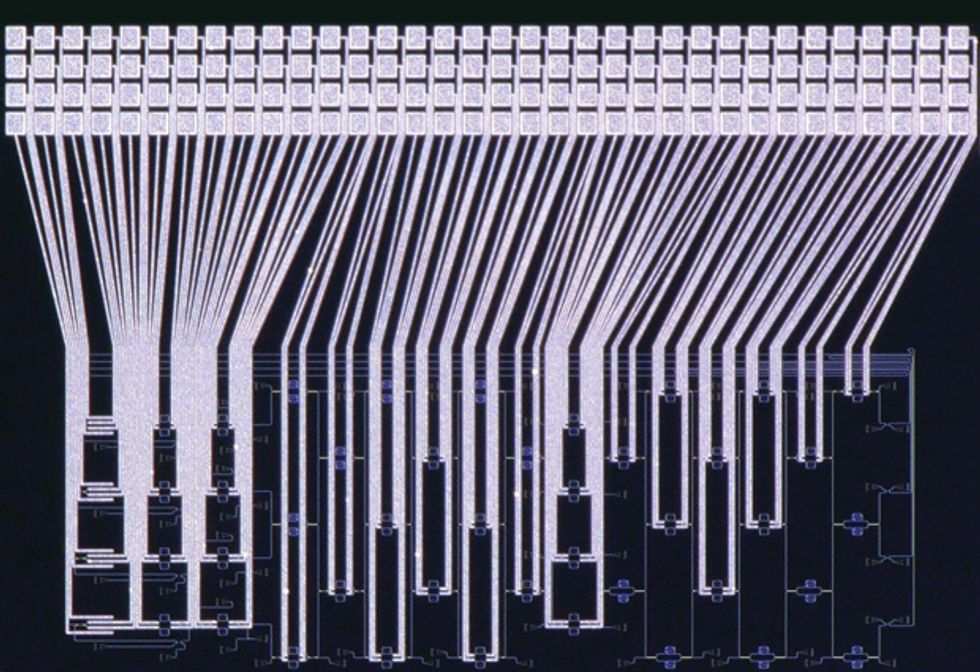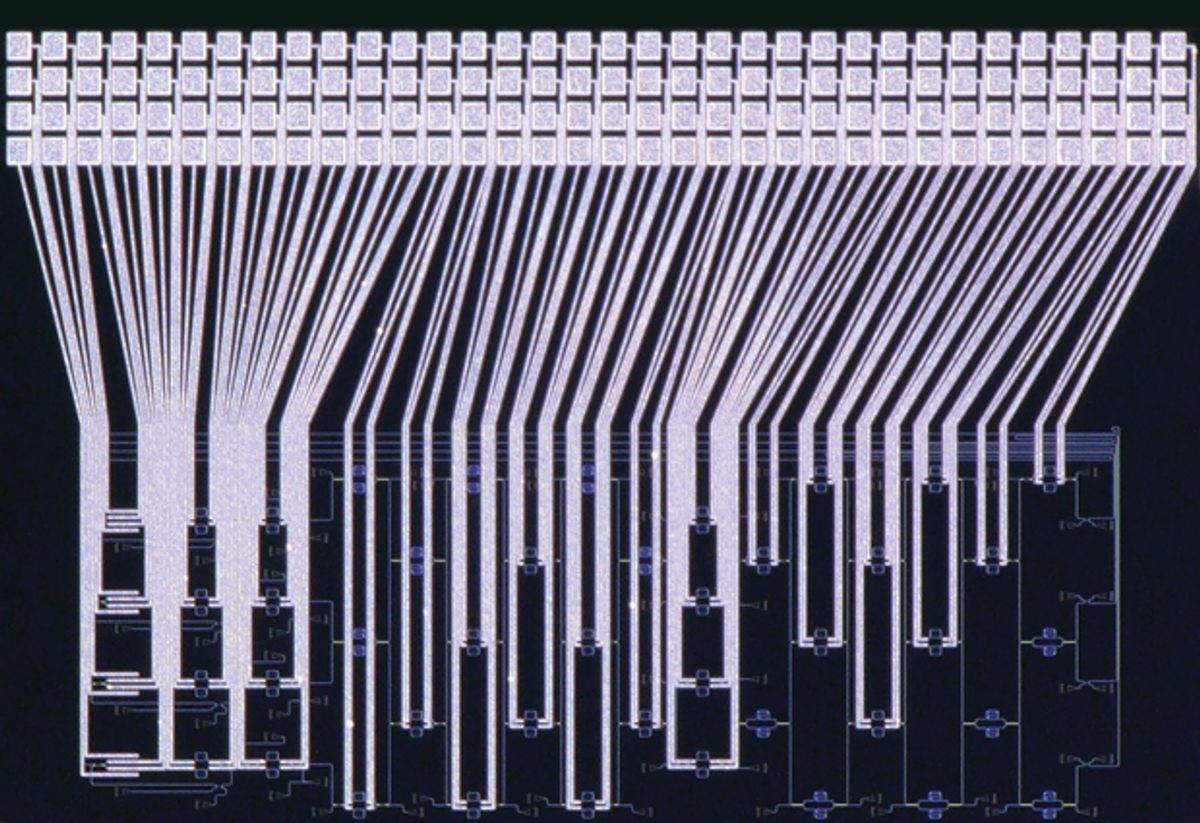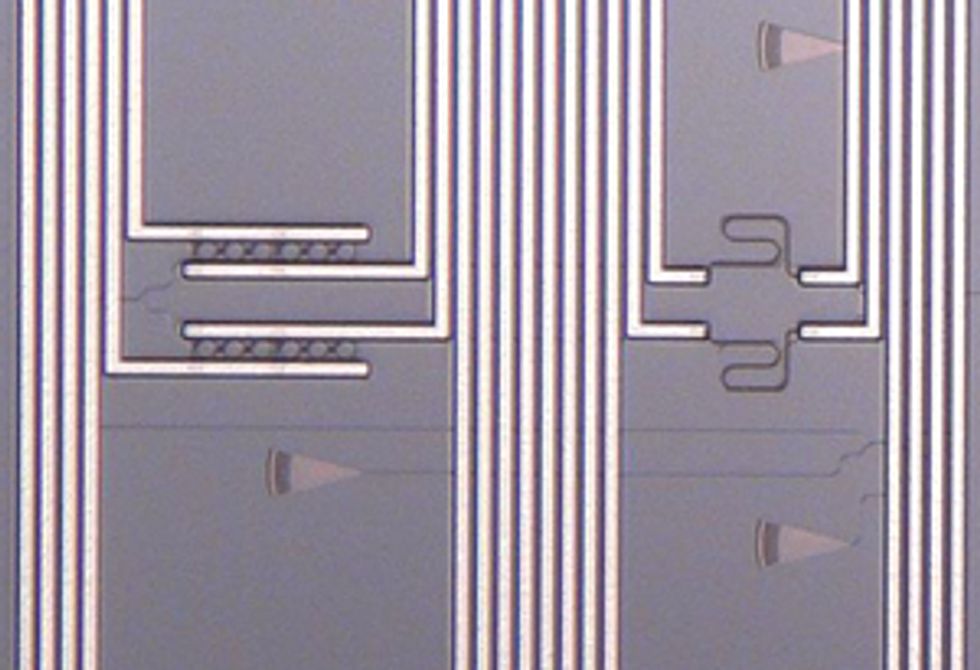
We may use photons to carry our data, but we rely on the electron to put it to use. One day that division of labor might not be so stark. A team at Hewlett Packard Labs, in Palo Alto, Calif., has built a demonstration chip that could help push some particularly thorny computations into the realm of light, potentially boosting speed and saving energy in the process.
Silicon integrated circuits containing parts that can manipulate light are not new. But this chip, which integrates 1,052 optical components, is the biggest and most complex in which all the photonic components work together to perform a computation, says team member Dave Kielpinski, a senior research scientist at Hewlett Packard Labs (now a part of Hewlett Packard Enterprise, or HPE). “We believe that it is by a wide margin,” he says.
The chip, which was developed through the U.S. Defense Advanced Research Projects Agency’s Mesodynamic Architectures program and was still undergoing testing as IEEE Spectrum went to press, is an implementation of an Ising machine—an approach to computation that could potentially solve some problems, such as the infamous “traveling salesman problem,” faster than conventional computers can.
The Ising approach is based on a century-old model for how the magnetic fields of atoms interact to give rise to magnetism. The model envisions every atom as having a property called “spin” that prefers to point either up or down. In a ferromagnetic material, above a certain temperature, these spins are oriented randomly and are flipped repeatedly by heat. But when the temperature falls below a certain threshold, the interactions between the atoms dominate, and most of the spins settle down to point in the same direction.
Computers inspired by this model—so-called Ising machines—use such settling actions to arrive at answers to optimization problems. The problem to be solved is entered into the machine by tuning the interactions between its computational elements. These elements, the spins, are designed to be in one of two states and interact with one another until they settle into an optimal configuration that corresponds to a low-energy state.
Stanford University’s Yoshihisa Yamamoto pioneered an approach to building such a machine with light. The spins in his system are two phases of light that are 180 degrees out of phase of each other. In 2014, Yamamoto and his colleagues reported the construction of a four-spin machine based on this idea in the laboratory, built with mirrors, lasers, and other optical components.
But scaling up the machine was complicated by a macroscopic effect—ordinary acoustic noise, says Peter McMahon, a member of Yamamoto’s group at Stanford. Even the vibrations created by someone emptying a nearby waste bin could cause a subtle expansion or contraction of a delay line, a part of the system that is used to impart delays so that spins can interact properly when they meet. This kind of expansion or contraction could alter the phase of the light enough to disrupt computation. While such perturbations can be corrected, McMahon says, scaling up the system was looking as though it was going to be an impractical and expensive prospect. So in the end, the team altered their approach, introducing electronic feedback into the mix. In October 2016, McMahon and his colleagues reported in the journal Science that they had used this hybrid optical-electronic system to create an Ising machine with 100 spins. Research reported in the same issue by a number of the same scientists extended the technique to create a more specialized, 2,000-spin computer.
The HPE chip is designed to be a compact approach that doesn’t need such electronic feedback. Four areas on the chip, called nodes, support four spins made of infrared light. After the light exits each node, it is split up and combined with light from each of the other nodes inside an interferometer. Electric heaters built into the interferometer are used to alter the index of refraction and physical size of nearby components. This adjusts the optical path length of each light beam—and thus its phase relative to the other beams. The heater temperatures encode the problem to be solved, as they determine how strongly the state of one spin is weighed against another when two beams are combined. The outputs of all these interactions are then condensed and fed back into the nodes, where structures called microring resonators clean up the light in each node so it once again has one of two phases. The light cycles over and over through the interferometer and the nodes, flipping spins between phases of 0 degrees and 180 degrees until the system equilibrates to a single answer.
McMahon says this system could eliminate the vibrational problem faced by the 2014 Ising machine. “If you integrate everything on a small chip,” he says, the paths that light takes are etched in silicon. “Those are almost by definition very fixed things,” he explains, such that any vibration or temperature swing will tend to affect all the paths that light can take equally. But McMahon notes it’s still early days for this approach to computing; the basic physics by which these optical systems arrive at equilibrium still needs to be explored, he says, as does their potential competitiveness with conventional machines.
A key aim of HPE’s chip project, Dave Kielpinski says, was to push the limits of photonic chip design. “One of the things we’re proudest of is our computer-aided layout tools,” he says. He presented the chip in October in San Diego at the inaugural IEEE International Conference on Rebooting Computing, which gathered researchers investigating a number of alternatives that could help keep improving computers as Moore’s Law peters out.
In the future, Ising chips such as these might be able to act as accelerators, speedy specialists much like the graphics processing units used in many of today’s machines. Kielpinski says the team is investigating designs that could be used to scale up to a larger number of spins.
This article appears in the January 2017 print issue as “The Ising on the Computer Chip.”

